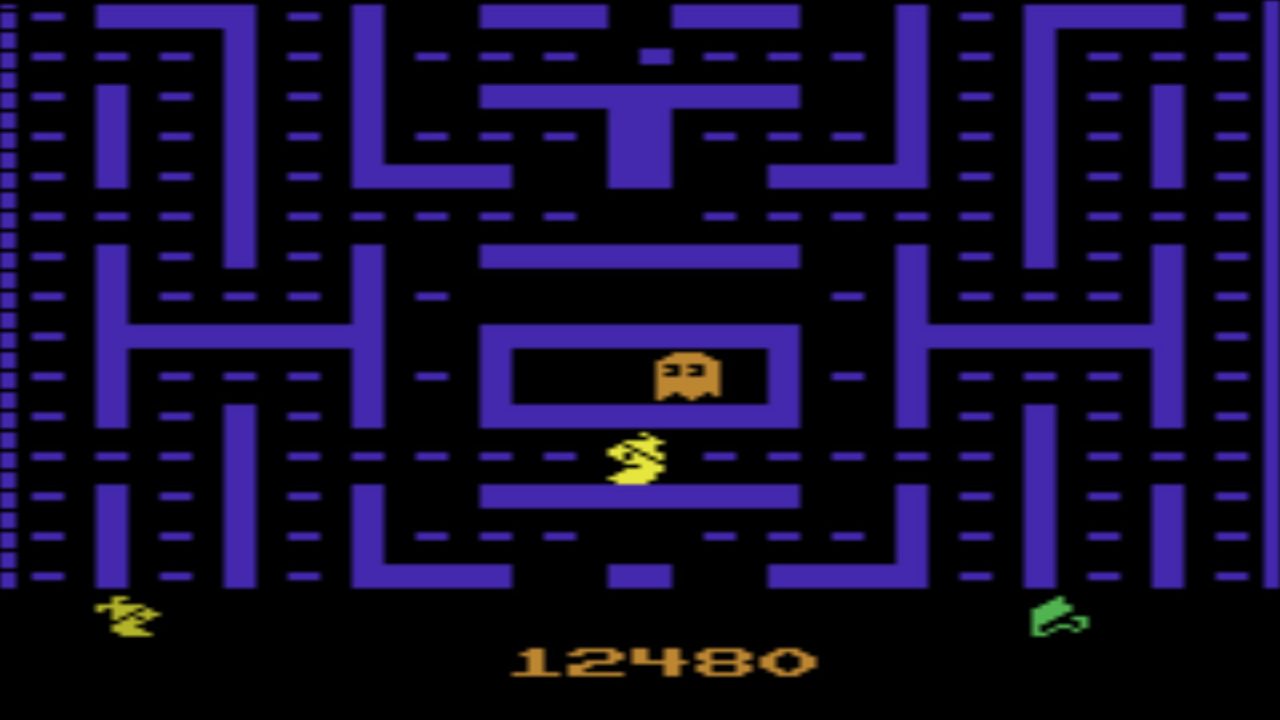Jr. Pac-Man
I wonder how many people have never heard of this game?
This game is somewhat lost to the annals of time as Bally Midway created this game without Namco’s permission and is cited as one of the projects which severed the two’s relationship.
Jr. Pac-Man is yet another spin-off of the tried-and-true formula which stormed arcades with the original Pac-Man and its most famous incarnation, and another originally unapproved Namco mod, Ms. Pac-Man.
Junior probably isn’t as well-known because the changes to the classic formula aren’t, well, classic – at least when compared with Ms. Pac-Man.
Instead of a pink bow, Junior wears a beanie. The ghosts are the same, the pellet-eating the same, the cutscenes tell of some weird relationship with a girl ghost, and the items just swap of to being kid-styled.
The goal of the game is the same: eat all of the pellets without losing all of your lives. You start with three lives, the standard, and try to avoid touching any of the four ghosts.
The game looks like a bootleg but plays like a mofo.
Seven total mazes appear in the game, with most of them increasing the power pellets to six instead of four. For the unfamiliar, the energizers allow you a brief amount of time to eat the ghosts. I found Junior to be a lot faster to adapt to, especially with the speed of the ghosts and the lack of time a power pellet (or “energizer”) lasts… sometimes a mere second or two.
By comparison, Ms. Pac-Man feels like you’re playing in slow-motion, even on the first level!
There are no escape tunnels and the boards seem massive compared with its predecessors, as the screen scrolls horizontally rather than showing the entire level on-screen.
Those items? They make the game more difficult if you don’t grab them, as each pellet it touches gets bigger – giving you a higher score but slowing you down further. If the item touches a power pellet, both the pellet and item disappear.
I understand trying to capitalize on the Pac-Man craze with another variation at the time. However, the changes to Junior seem like a “World Champions” type of challenge rather than appealing to the casual gamer.
Years later I now understand why this cartridge was seldom played on my Atari, although, the video game crash of the 80’s saw me pick this up in the discount bin for a mere $3 – likely the reason I didn’t despise the game as much then as I do now in this review. (Plus, games were just understood to be ridiculously difficult to play back then!)
For Pac-Man fans, check it out. For those who want a challenge – check it out.
For all others? Meh, still check it out. I just don’t promise that the trip down memory lane will necessarily be a fun one!
Pac-Man
One of the most beloved video game franchises of all time, I had a difficult choice to make when deciding which version of the original Pac-Man I wanted to play as part of my reviews.
Originally an arcade game, the mega popular Pac-Man has been released on practically every gaming platform known to man. It was released for the Atari 2600 a year following its arcade release, and then saw releases for other Atari platforms, the Apple II, Commodore 64, IBM PC, Intellivision, NES, Game Boy, Game Gear, heck, it even has a Windows Phone release.
Sticking as close to the original source as possible, I felt the NES version was superior to the Atari 2600 experience and stuck with it. As far as I can tell, the controls are tight, the graphics and sound are both faithful to the arcade version.
As for Pac-Man itself, yes, I love this game. But after a while? It can be challenging.
Heck, even a few levels in it’s a challenge! Never mind the fact there are over 250 of them!
Regardless, the beeps and boops of Pac-Man chomping pellets is the stuff childhoods were built from. I still love this game to this day and it’s a “go to” when introducing young kids or new players to the wonderful world of video games.
One more fun fact about this game: it’s one of three officially licensed Nintendo titles produced by Atari’s subdivision Tengen. Tengen eventually reverse engineered the security lockout features of the NES and began producing games for the console without paying Nintendo’s royalty fee.
According to Wikipedia:
Tengen manufactured both licensed and unlicensed versions of three of their NES games (Gauntlet, Pac-Man, and R.B.I. Baseball). Their cartridges for unlicensed games do not come in the universally recognizable gray, semi-square shape that licensed Nintendo games come in; instead, they are rounded and matte-black, and resemble the original Atari cartridges.
